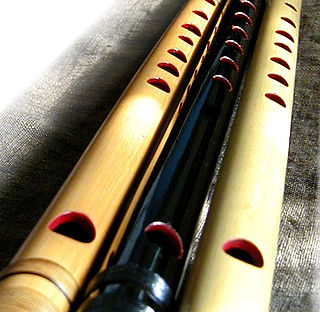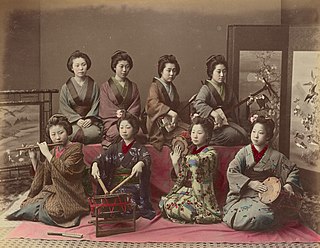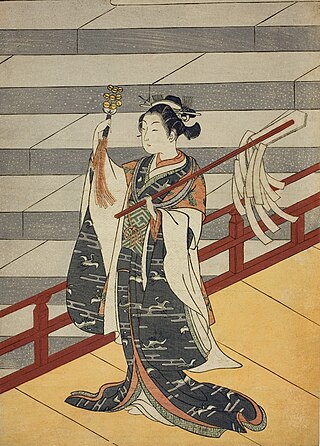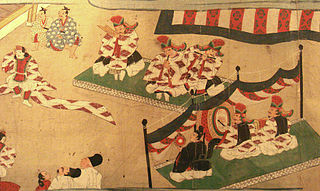
The minteki (kanji: 明笛; also called shinteki (kanji: 清笛)) is a Japanese transverse bamboo flute, a fue. It was first introduced to Japan from China in 1629. [1] It is found in minshingaku (明清楽) ensembles. [2]

The minteki (kanji: 明笛; also called shinteki (kanji: 清笛)) is a Japanese transverse bamboo flute, a fue. It was first introduced to Japan from China in 1629. [1] It is found in minshingaku (明清楽) ensembles. [2]
Shinto music is the ceremonial and festive music of Shinto (神道), the indigenous religion of Japan. Its origin myth is the erotic dance of Ame-no-Uzume-no-Mikoto which lured Amaterasu from her cave.
Gagaku is a type of Japanese classical music that was historically used for imperial court music and dances. Gagaku was developed as court music of the Kyoto Imperial Palace, and its near-current form was established in the Heian period (794-1185) around the 10th century. Today, it is performed by the Board of Ceremonies in the Tokyo Imperial Palace.
Okinawan music is the music associated with the Okinawa Islands of southwestern Japan. In modern Japan, it may also refer to the musical traditions of Okinawa Prefecture, which covers the Miyako and Yaeyama Islands in addition to the Okinawa Islands. It has its roots in the larger musical traditions of the Southern Islands.
Kyōiku kanji, also known as Gakunenbetsu kanji haitōhyō is a list of 1,026 kanji and associated readings developed and maintained by the Japanese Ministry of Education that prescribes which kanji, and which readings of kanji, Japanese students should learn from first grade to the sixth grade. Although the list is designed for Japanese students, it can also be used as a sequence of learning characters by non-native speakers as a means of focusing on the most commonly used kanji.

The shinobue is a Japanese transverse flute or fue that has a high-pitched sound. It is found in hayashi and nagauta ensembles, and plays important roles in noh and kabuki theatre music. It is heard in Shinto music such as kagura-den and in traditional Japanese folk songs. There are two styles: uta (song) and hayashi (festival). The uta is properly tuned to the Western scale, and can be played in ensembles or as a solo instrument.
Tō-on, also pronounced "tō-in", are Japanese kanji readings imported from China by Zen monks and merchants during and after the Song dynasty. This period roughly corresponds with the mid-Heian to Edo periods of Japan. During the Muromachi period, they were referred to as "sō-on". Together, they are collectively known as "tōsō-on" (唐宋音).

Traditional Japanese musical instruments, known as wagakki (和楽器) in Japanese, are musical instruments used in the traditional folk music of Japan. They comprise a range of string, wind, and percussion instruments.
The kanji of the year is a character chosen by the Japanese Kanji Proficiency Society through a national ballot in Japan, starting in 1995. The character with the most votes, selected to represent the events of that year, is announced in a ceremony on December 12 at Kiyomizu Temple.

Kagura is a type of Shinto ritual ceremonial dance. The term is a contraction of the phrase kami no kura, indicating the presence of gods in the practice.

Traditional Japanese music is the folk or traditional music of Japan. Japan's Ministry of Education classifies hōgaku as a category separate from other traditional forms of music, such as gagaku or shōmyō, but most ethnomusicologists view hōgaku, in a broad sense, as the form from which the others were derived. Outside of ethnomusicology, however, hōgaku usually refers to Japanese music from around the 17th to the mid-19th century. Within this framework, there are three types of traditional music in Japan: theatrical, court music, and instrumental.
The kagurabue (神楽笛) is a six or seven-hole transverse bamboo flute used to support Japanese kagura performance.

Masumida Shrine is a Shinto shrine in the Masumida neighborhood of the city of Ichinomiya in Aichi Prefecture, Japan. It is the ichinomiya of former Owari Province. The main festival of the shrine is held annually on April 3.

The Nagasaki incident, also known as the Nagasaki―Qing Navy Incident (長崎清国水兵事件), was an August 1886 riot involving Chinese Beiyang Fleet sailors in Nagasaki.
Yukiyoshi Ozawa is an American-born Japanese actor.
Kanji Ishimaru is a Japanese musical actor and singer. Ishimaru is signed to Sony Music Entertainment Japan. He grew up in Ichihara, Chiba and graduated from Tokyo University of the Arts.

Omega Tribe was a Japanese soft rock and city pop project that was led by producer Koichi Fujita, with the bands being handled by industry veterans Tetsuji Hayashi, Tsunehiro Izumi, and Hiroshi Shinkawa at different points of the band's existence. The project was active from the early 1980s to the late 1990s, having several hits during its lifespan with the help of lyricists, composers, and arrangers. The band underwent several core member changes as well as name changes, with the band changing vocalists three times with the introductions of Kiyotaka Sugiyama in 1983, Carlos Toshiki in 1986, and Masahito Arai in 1993. The band has also had many offshoot bands that have stemmed from members collaborating. Many of the band's works were focused on themes of summer, sea, and resorts, making them one of the leading bands with summer songs along with Southern All Stars and Tube. They have also been called one of the pioneers of Japanese soft rock in the 1980s.

Toshitsugu Nishihara is a Japanese musician and composer, and the former keyboardist of Omega Tribe.

The Ariake West Canal is a canal located between Ariake, Koto-ku, in Tokyo and Odaiba, Minato-ku.